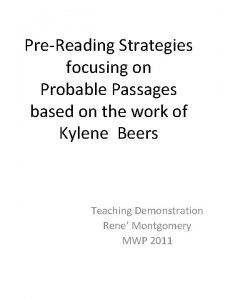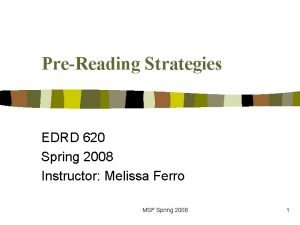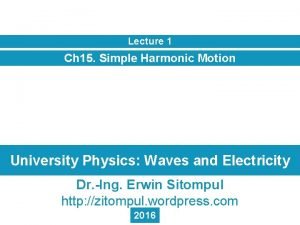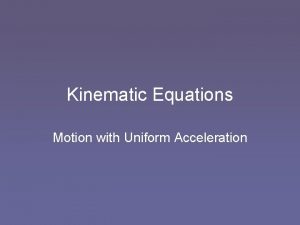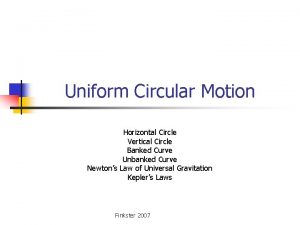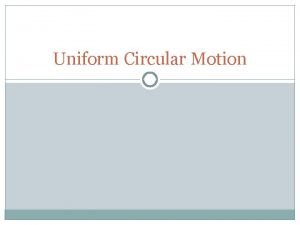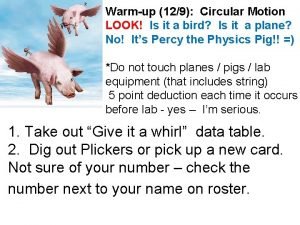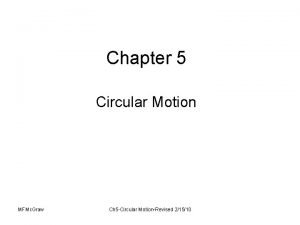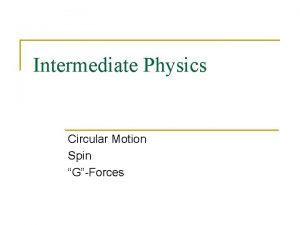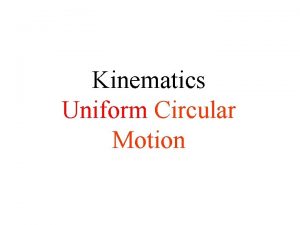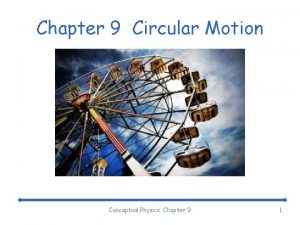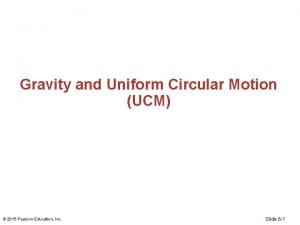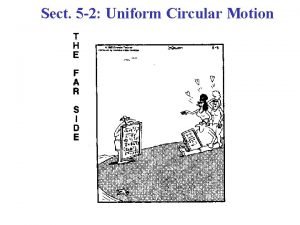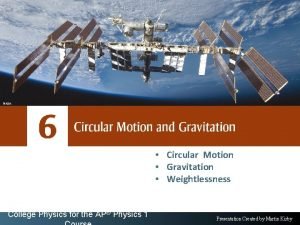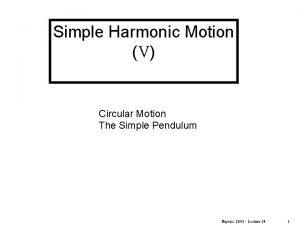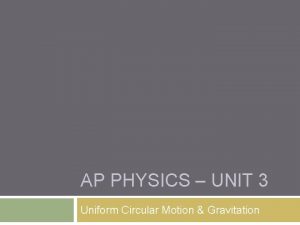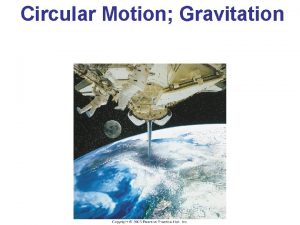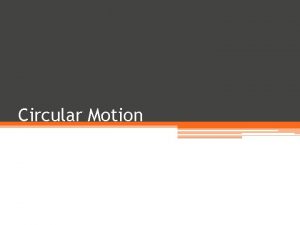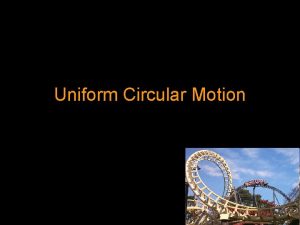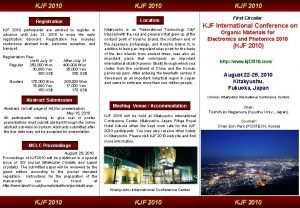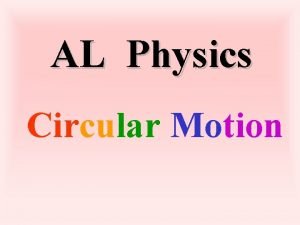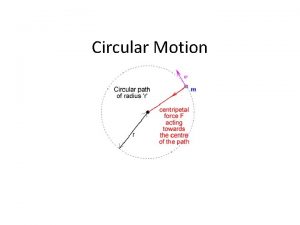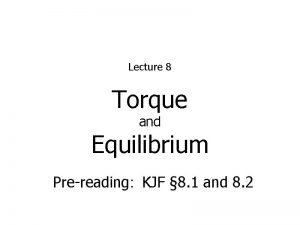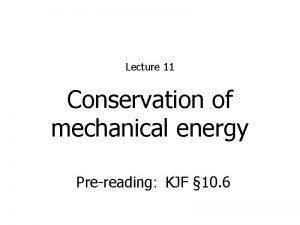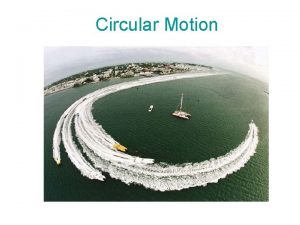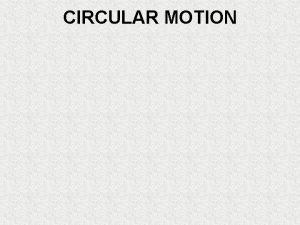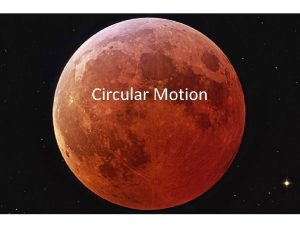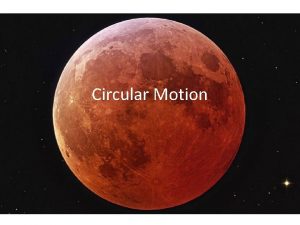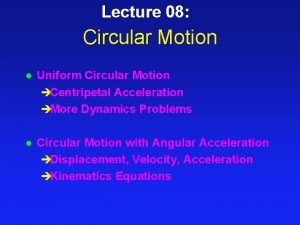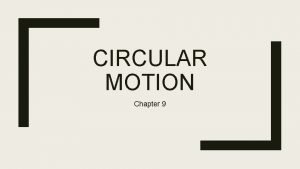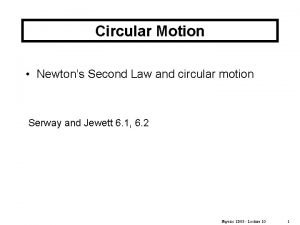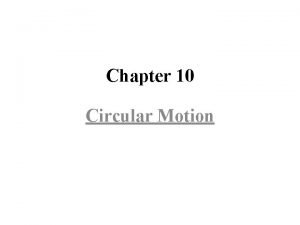Lecture 6 Circular Motion Prereading KJF 6 1






















- Slides: 22

Lecture 6 Circular Motion Pre-reading: KJF § 6. 1 and 6. 2

Circular motion KJF § 6. 1– 6. 4

Angular position If an object moves in a circle of radius r, then after travelling a distance s it has moved an angular displacement θ: θ is measured in radians (2π radians = 360°) KJF § 3. 8 5

Tangential velocity If motion is uniform and object takes time t to execute motion, then it has tangential velocity of magnitude v given by Period of motion T = time to complete one revolution (units: s) Frequency f = number of revolutions per second (units: s– 1 or Hz) 6

Angular velocity Define an angular velocity ω Uniform circular motion is when ω is constant. Combining last 3 equations: v = rω period KJF § 6. 1 7

Question You place a beetle on a uniformly rotating record (a) Is the beetle's tangential velocity different or the same at different radial positions? (b) Is the beetle's angular velocity different or the same at the different radial positions? Remember; all points on a rigid rotating object will experience the same angular velocity 8

Consider an object is moving in uniform circular motion – tangential speed is constant. Is the object accelerating? Velocity is a vector ∴ changing direction ⇒ acceleration ⇒ net force 9

The change in velocity Δv = v 2 – v 1 and Δv points towards the centre of the circle Angle between velocity vectors is θ so Δv = vθ and so KJF § 3. 8 10

Centripetal acceleration Acceleration points towards centre – centripetal acceleration ac Since the object is accelerating, there must be a force to keep it moving in a circle This centripetal force may be provided by friction, tension in a string, gravity etc. or combinations. KJFExamples? § 6. 2 11

Note that centripetal force is the name given to the resultant force: it is not a separate force in the freebody diagram. The centripetal acceleration has to be provided by some other force (tension, friction, normal force) in order for circular motion to occur. 12

Solving CM problems • • Draw a free-body diagram • The magnitude of this net force is given by If the object is moving in a circle, there must be a net force pointing towards the centre of the circle. 13

Problem 1 You enter the carnival ride called "The Rotor". The circular room is spinning and you and other riders are stuck to the circular wall. • Draw a free-body diagram of the woman in red • Is she in equilibrium? Explain • What force is providing the centripetal force? 14

Whirling bucket A bucket of water is whirled around in a vertical circle with radius 1 m. What is the minimum speed that it can be whirled so the water remains in the bucket? [3 ms– 1, or rotation period 2 s] 15

Clicker questions

A beetle is sitting on a rotating turntable. Looking at the turntable side on, so the centre is towards the right: Which diagram correctly shows the forces acting on the beetle? (a) (b) (c) (d) (e) other

There is a centripetal force acting on the beetle. What provides this force? (a)the angular velocity of the turntable (b)gravity (c)tangential velocity (d)friction (e)centripetal acceleration (f)normal force

The turntable starts to spin faster. Which direction should beetle move so as not to slip? (a)inwards (b)outwards (c)forward in the direction of motion (d)backwards away from the direction of motion

Car around a corner A car of mass 1. 6 t travels at a constant speed of 72 km/h around a horizontal curved road with radius of curvature 190 m. (Draw a free-body diagram) What is the minimum value of μs between the road and the tyres that will prevent slippage? [0. 21] 20

Car over a hill A car is driving at constant speed over a hill, which is a circular dome of radius 240 m. Above what speed will the car leave the road at the top of the hill? [175 km/h] 21

Banked road On a curve, if the road surface is "banked" (tilted towards the curve centre) then the horizontal component of the normal force can provide some (or all) of the required centripetal force. Choose v & θ so that less or no static friction is required. KJF example 6. 6 22

KJF example 6. 6 A curve of radius 70 m is banked at a 15° angle. At what speed can a car take this curve without assistance from friction? [14 ms– 1 = 50 km h– 1] KJF example 6. 6 23

Next lecture Centre of mass and Torque Read: KJF § 7. 2, 7. 3
 Moodle kjf
Moodle kjf Prereading strategies
Prereading strategies Prereading strategies
Prereading strategies 01:640:244 lecture notes - lecture 15: plat, idah, farad
01:640:244 lecture notes - lecture 15: plat, idah, farad Which element of hair design refers to wave patterns
Which element of hair design refers to wave patterns Simple harmonic motion lecture
Simple harmonic motion lecture Simple harmonic motion lecture
Simple harmonic motion lecture Kinematic equations for circular motion
Kinematic equations for circular motion Angular acceleration formula in terms of radius
Angular acceleration formula in terms of radius Static friction formula
Static friction formula Circular motion lab
Circular motion lab Acceleration in circular motion formula
Acceleration in circular motion formula Circular motion conceptual questions
Circular motion conceptual questions Circular motion
Circular motion Circular motion
Circular motion Circular motion
Circular motion Circular motion conceptual physics
Circular motion conceptual physics Normal force in uniform circular motion
Normal force in uniform circular motion Circular motion definition
Circular motion definition Circular motion images
Circular motion images Time period of circular motion
Time period of circular motion Ap physics unit 3 circular motion and gravitation
Ap physics unit 3 circular motion and gravitation Curvilinear motion
Curvilinear motion

